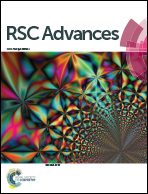Green synthesis of silver nano/micro particles using TKP and PVA and their anticancer activity
Abstract
This paper describes the green synthesis of core–shell silver nano/micro particles (AgNP/MPs) using poly (vinyl alcohol) (PVA) and tamarind kernel powder (TKP) as reducing cum stabilizing agents. Effect of both mean hydrodynamic sizes and zeta potentials of the polymeric reactants on size and stability of silver particles has been investigated. Resultant particles have been further studied for exertion of the cytotoxic effect on human epithelial carcinoma cell line (HeLa). The synthesis was carried out from aqueous silver nitrate (AgNO3) at 70 °C using various concentrations of PVA, TKP and pH. The average size of the silver particles varied between 19.01 to 613 nm as determined from ultraviolet spectroscopy and dynamic light scattering measurements, complemented by transmission electron microscopy. Zeta potentials of the particles varied subject to preferential adsorption of either TKP or PVA on the shell. Field emission scanning electron microscopy revealed various shapes of bulk AgNP/MPs. Energy dispersive X-ray mapping showed, with change in conditions, that the size of the silver core did not change drastically, however, the thickness of the polymer-shell changed significantly. Cytotoxicity study with average particle sizes between 19.01–350 nm on HeLa showed a dose-responsive activity however, up to the lethal dose of 50 μg ml−1 the nanoparticles exhibited adequate selectivity in killing the cancer cells compared to the normal cells.


 Please wait while we load your content...
Please wait while we load your content...